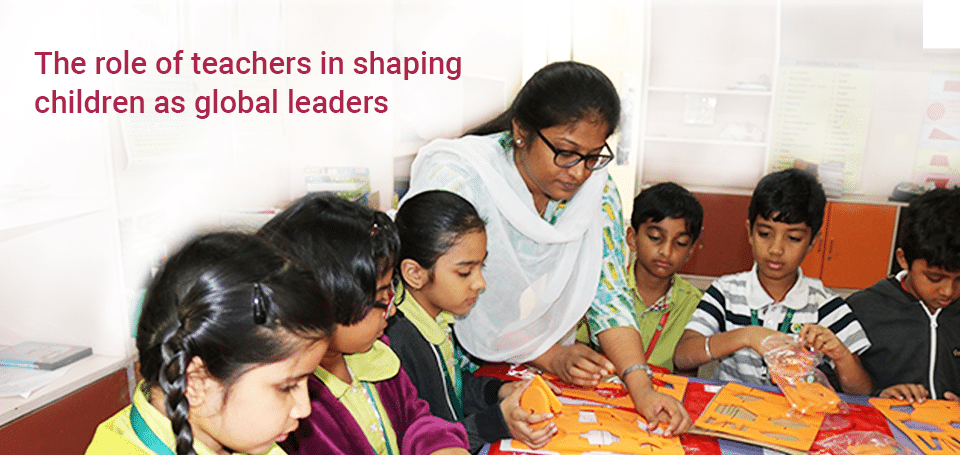The students of today are the leaders of tomorrow. Nothing can sum up the importance of a complete education system better. Teachers play the most important role in shaping the society of tomorrow. The world is interconnected and the changing times emphasize most on leaders who can lead fearlessly and with respect for diverse perspectives and cultures.
When education is integrated successfully with principles of collaboration and problem-solving, it is not only engaging for the student but is also a step forward to building leaders of tomorrow.
When schools apply terms like "leadership skills" and "global leader" through meaningful programs and strategies for student development it surely enhances leadership skills in students, to help them better listen, observe, interpret and relate to others and the world they live in.
So how do teachers apply these strategies to teach children so that it encourages leadership from the start?
Here are five principles that make a global leader and strategies for teachers who can facilitate this learning for children in the best way possible:
1. Effective stress management
As teachers, it is not what we say but what we do that deeply impacts the class. When teachers raise above stressful situations by staying flexible, yet, committed the message is clear. We all need to tune in, with a deep breath and then see the results. It works.
Here's how to help students manage stress
Help your students understand the importance of time management and observation. Especially during exam times, it is equally important to stay organized with academics as well as incorporating 5-10 minutes of downtime to ease out the stress of examinations and peer pressure. It could be anything from deep-breathing, meditation, singing or stress-busting with music. Try this; it's a great way to stay grounded.
2. Effective communication skills
A teacher can express himself/herself with confidence and clarity both verbally and non-verbally. A teacher is a mentor to young adults who is respectful of others' time and perspectives. It means a teacher is a good speaker as well as a good listener.
Here's how to impart this to children
To impart this in a classroom, engage the children in practicing public speaking, presentations, role-playing, or even short current news briefings. Make the session interactive with students understanding their strengths and limitations, so that they can work on that better the next time. As an extended idea, you could let them take hand-written notes on each other's' presentation and use this platform for group discussions so that more children come out of their fear of talking. Encourage children to participate, even if it's just two or three points. It doesn't matter; however, involving every child in the classroom makes the learning environment equal and encouraging.
3. Continuous learning experience
We are all learning something new each day. With wider knowledge, we gain better perspectives and can process and adapt to change for the better.
Get your students ready for change
Expose your students to new ideas for a wider breadth of learning. Have them research a topic and let them teach it to the class in 5-10 minute segments. This autonomy will bring in them a sense of responsibility and enthusiasm as they share their learning.
4. Behavioral flexibility
Learning new topics from the book can get you a grip on the subject. How about widening the scope of learning beyond the textbook and classroom?
Tuning into new, positive behaviors through creative pursuits
Encourage your students to enhance their skills with professional development workshops, or by joining a sports club poetry reading club or any such networking events that can motivate their inner self into achieving something more. This networking can bring them in touch with experts who can help the young adults fine-tune, enhance their abilities.
5. Out-of-the-box approach
As a facilitator when you approach old problems with new ideas by stretching beyond what "is" into what "could be," you inspire your students to do the same.
Involve, collaborate with the students
How can one make learning interesting? Ask the class what they think will help improve the learning and problem-solving process. Would they like to participate in field training or will a discussion with an industry expert add value? Chalk out different strategies to make the subjects interesting and go beyond the routine.
Bringing the World into Classrooms
Along with these basic principles teachers must do their best to integrate global topics and perspectives in the existing unit of study. They can do this by:
- Integrating global issues in their unit of study. For example, teaching math by understanding and integrating population studies across the globe.
- Providing opportunities for real engagement with global issues. For example, encourage pen-pal exchange with schools from other countries making this not just a friendly exchange but inquiry-based learning wherein you can learn and address global issues.
- Integrating global experiences into the classroom. This can be achieved via photo exhibitions held in school thereby increasing the awareness of children in relation to various global cultures.
- Encouraging respect and appreciation for diversity and social responsibility by collaborating with people coming from diverse backgrounds.


